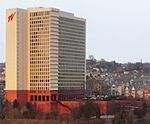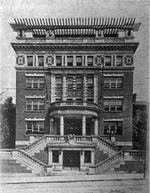Saint Joseph's House of Hospitality (Pittsburgh)
St. Joseph's House of Hospitality is a home for homeless men in Pittsburgh, Pennsylvania. It was founded in 1937 by the Catholic Radical Alliance on the principles of the Catholic Worker Movement, and is named for St. Joseph the Worker. As a house of hospitality, the homeless are guests of the house, similar to being guests of a family, and they are charged a fee based on a sliding scale. Past resident directors have included Monsignor Charles Owen Rice. During the early 1950s the House, then in Tannehill Street, was managed by Paul J Rudzik, who lived on the premises with his wife and two daughters. It has moved from its original location, but is still in the Hill District at 1635 Bedford Avenue, Pittsburgh PA (+1 412 471-0666). The current facility provides single-occupancy locked rooms. It is operated by Catholic Charities of the Roman Catholic Diocese of Pittsburgh.There are or were similar houses with the same name in New York City and Rochester, New York.
Excerpt from the Wikipedia article Saint Joseph's House of Hospitality (Pittsburgh) (License: CC BY-SA 3.0, Authors).Saint Joseph's House of Hospitality (Pittsburgh)
Manilla Street, Pittsburgh
Geographical coordinates (GPS) Address Nearby Places Show on map
Geographical coordinates (GPS)
| Latitude | Longitude |
|---|---|
| N 40.44492 ° | E -79.98639 ° |
Address
Manilla Street 700
15219 Pittsburgh
Pennsylvania, United States
Open on Google Maps










